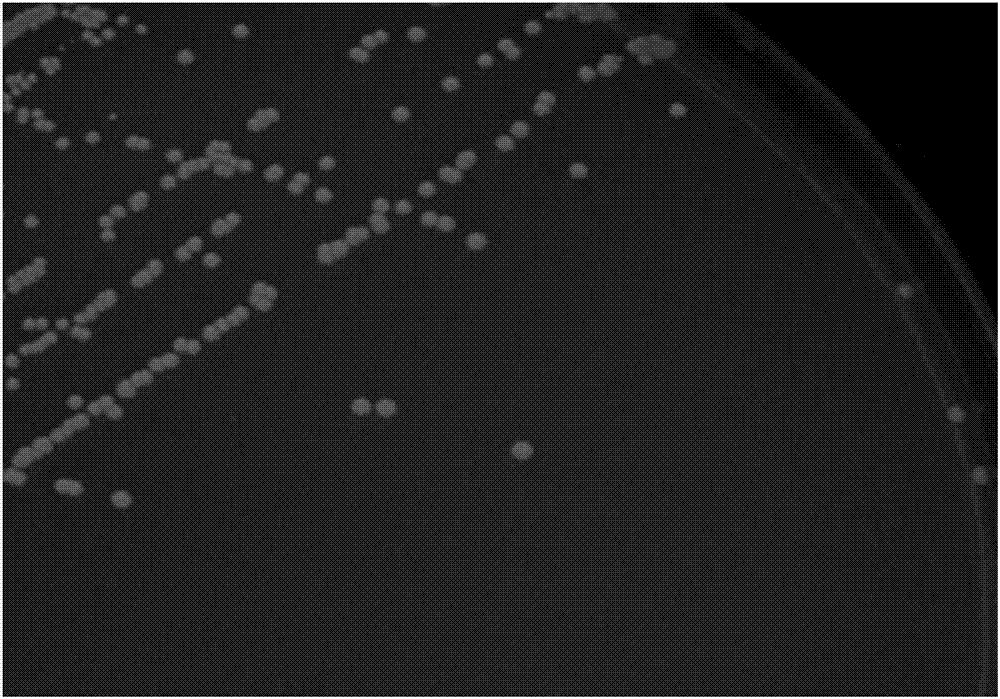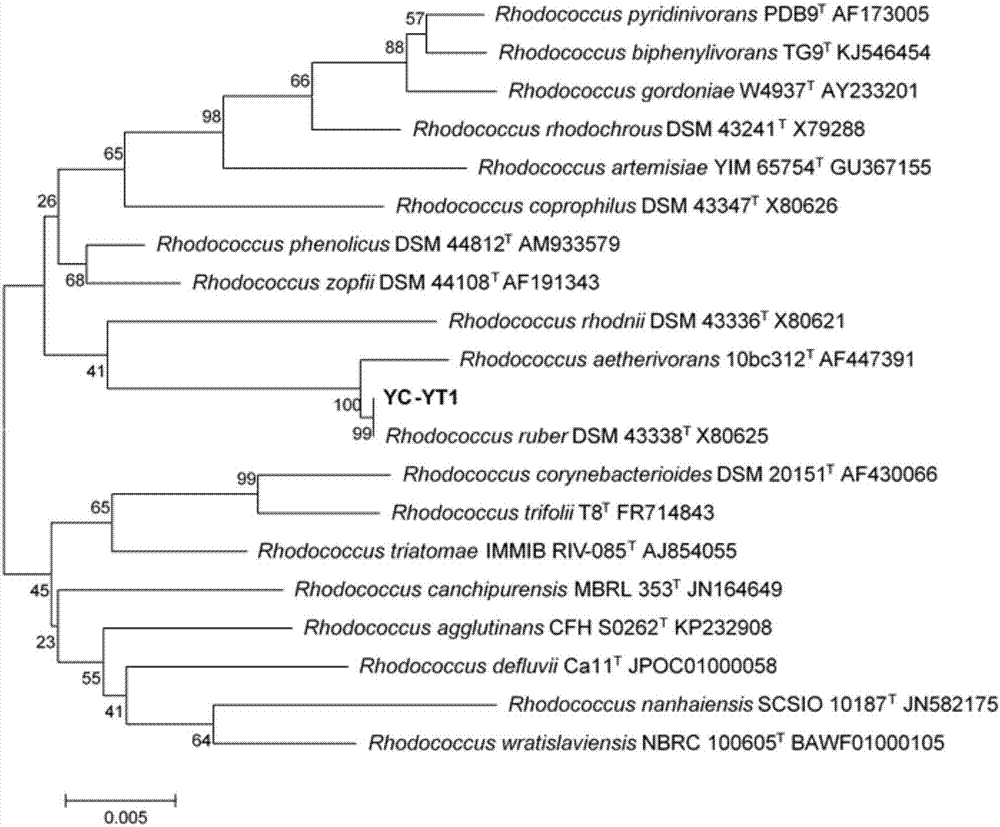Rhodococcus ruber capable of degrading phthalates and application thereof
A technology of phthalic acid and Rhodococcus, which is applied in the field of microorganisms and biodegradation, can solve the problems of protein research, less enzyme gene research, harsh environmental conditions of industrial wastewater, etc., and achieve the effect of broad degradation spectrum and stable degradation ability
- Summary
- Abstract
- Description
- Claims
- Application Information
AI Technical Summary
Problems solved by technology
Method used
Image
Examples
Embodiment 1
[0032] Isolation and Identification of Example 1 Rhodococcus Erythrococcus YC-YT1
[0033] 1. Isolation of strains
[0034] Activated sludge samples were collected in the canal near Wangtang Industrial Zone, Xinwei Village, Xili Town, Nanshan District, Shenzhen, Guangdong Province. Under aseptic conditions, inoculate 10g of activated sludge samples into 100mL of inorganic salt ion medium containing 100mg / L DEHP, and cultivate them at 30°C and 180rpm. After every 7 days of culture, take 5% of the culture volume and transfer it to fresh inorganic salt medium, and increase the concentration of DEHP by 100mg / L each time, and transfer continuously for 3 times until the concentration of DEHP in the inorganic salt medium increases to 300mg / L.
[0035] Streak the acclimatized bacteria solution onto an inorganic salt medium plate containing 100mg / L DEHP, and culture in a 30°C incubator for 3 days. Pick a single colony on the plate and culture it after streaking, repeating three tim...
Embodiment 2
[0045] The degradation performance test of embodiment 2 Rhodococcus rubrum YC-YT1
[0046] 1. Rhodococcus erythrococcus YC-YT1 is resistant to di(2-ethylhexyl) phthalate (DEHP), dipropyl phthalate (DPrP) and butylbenzyl phthalate at a concentration of 100mg / L. Dimethyl phthalate (BBP), Dimethyl phthalate (DMP), Diethyl phthalate (DEP), Dibutyl phthalate (DBP), Diamyl phthalate (DAP), Dihexyl phthalate (DHP), diheptyl phthalate (DHPP), dicyclohexyl phthalate (DCHP), dioctyl phthalate (DOP), di For the degradation ability of nonyl ester (DNP) and didecyl phthalate (DDP), see Figure 4 .
[0047] Determination of di(2-ethylhexyl) phthalate (DEHP), dipropyl phthalate (DPrP) and butyl phthalate in inorganic salt medium of Rhodococcus rubrum YC-YT1 by high performance gas chromatography Benzyl benzyl ester (BBP), dimethyl phthalate (DMP), diethyl phthalate (DEP), dibutyl phthalate (DBP), dipentyl phthalate (DAP ), dihexyl phthalate (DHP), diheptyl phthalate (DHPP), dicyclohexyl ...
Embodiment 3
[0068] Example 3 Application of Rhodococcus Erythrococcus YC-YT1 in the Treatment of Wastewater Containing Various Phthalates
[0069] In the present embodiment, the inorganic salt ion medium (not sterilized) containing 70g / L NaCl is used as simulated wastewater (hereinafter referred to as "wastewater"), and a 5.0L fermenter (BioFlo 115, New Brunswick Scientific Co., NJ, USA ) for simulated wastewater treatment. Rhodococcus erythrococcus YC-YT1 was cultured in LB liquid medium to the logarithmic phase (OD 600 =0.8, the cell concentration is about 1.6×10 8 CFU / mL), adding the prepared bacterial solution to the wastewater to a final concentration of 8 × 10 7 CFU / L, 1.6×10 8 CFU / L, 3.2×10 8 CFU / L, 4.8×10 8 CFU / L, 6.4×10 8 CFU / L and 8.0×10 8 CFU / L wastewater (each treatment is 2L wastewater), and DEHP, DPrP, DBP, DOP and BBP were added to the wastewater at the same time to each concentration of 100mg / L, as a treatment group; at the same time, the same concentration of pollu...
PUM
 Login to View More
Login to View More Abstract
Description
Claims
Application Information
 Login to View More
Login to View More - R&D
- Intellectual Property
- Life Sciences
- Materials
- Tech Scout
- Unparalleled Data Quality
- Higher Quality Content
- 60% Fewer Hallucinations
Browse by: Latest US Patents, China's latest patents, Technical Efficacy Thesaurus, Application Domain, Technology Topic, Popular Technical Reports.
© 2025 PatSnap. All rights reserved.Legal|Privacy policy|Modern Slavery Act Transparency Statement|Sitemap|About US| Contact US: help@patsnap.com



